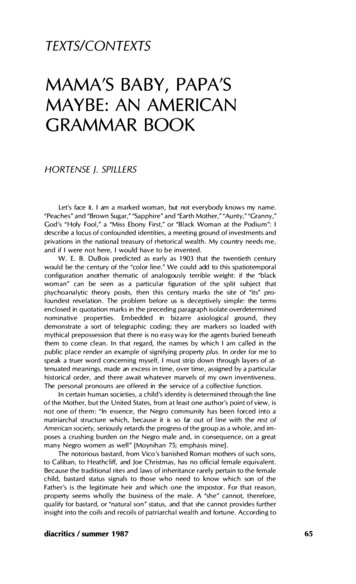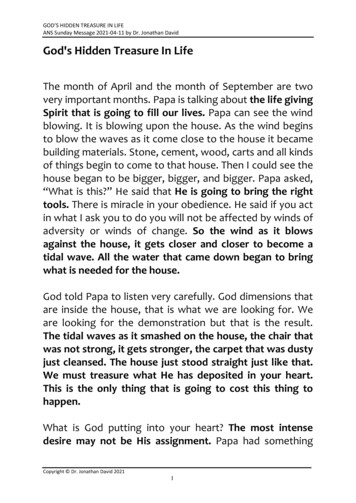
Transcription
TEXTS/CONTEXTSMAMA'S BABY, PAPA'SMAYBE: AN AMERICANGRAMMAR BOOKHORTENSE}. SPILLERSLet's face it. I am a m arked wom a n , but not everybody knows my name."Peaches" and "Brown Sugar," "Sapph i re " and "Earth Mother," "Au nty," "Gra n ny,"God 's "Holy Fool," a "Miss Ebony Fi rst," or "Black Wom a n at the Pod i u m ": Idesc r i be a locus of confou nded identities, a meeting gro u n d of i n vestments andprivations i n the natio nal trea s u ry of rhetorical wealth. My cou ntry needs me,and if I were not here, I wou ld have to be i n vented.W. E. B. Du Bois pred icted as ea rly as 1 903 that the twentieth centu rywould be the century of the "color line." We cou ld add to t h i s spatiotem poralconfigu ration a nother thematic of analogou sly terri ble weight: if the "blackwom a n " can be seen as a particular figu ration of the split s u bj ect thatp"sychoa nalytic theory posits, then t h i s centu ry m a rks the site of "its" pro fou ndest revelation. The problem before us is deceptively s i m ple: the termsenclosed in quotation marks in the preced i n g paragrap h isolate overdeter m i nednom i native properties. Em bedded in bizarre axiological gro u n d , theydemon strate a sort of telegra p h i c cod i n g; they a re markers so loaded withmyth ical prepossession that there is no easy way for the agents bu ried beneaththem to come clean. In t hat regard, the names by w h i c h I a m called in thepublic place render a n exam ple of signifying property plus. In order for me tospeak a truer word concern i ng myself, I m u st stri p down through layers of at ten u ated mea n i ngs, made an excess i n time, over time, assigned by a particularh i storical order, and there await whatever marve l s of my ow n i nve ntiveness.The personal prono u n s are offered in the service of a collective fu ncti o n .In certa i n h u ma n societies, a c h i ld 's identity i s dete r m i ned t h rough the l i n eo f the Mother, b u t the U n ited States, from a t least one author's poi nt o f view, i sn o t one o f t h e m : " I n essence, the N egro com m u n ity h a s bee n forced i nto amatriarchal st ructu re w h i c h , because it is so far out of l i n e with the rest ofA merican society, seriously retards the p rogress of the gro u p as a whole, and i m poses a crush i n g b u rden on the N egro male and, i n consequence, on a greatmany N egro women as wel l " [Moyn i h a n 75; em phasis m i ne].The notorious bastard , from Vico 's ba n ished Roman mothers of such son s,to Caliban, to Heathcliff, and Joe C h ristmas, has no official fem a le equ i valent.Because the trad itional rites and laws of i n h eritance rarely pertai n to the fem a lec h i ld, basta rd status signals to those who need to know which son of theFather's i s the legit i m ate h e i r and w h i c h one the i m postor. For that reason ,property see m s w holly the busi ness o f the male. A "she" ca n not, therefore,qualify for bastard, or "natu ral son " status, and that she can not provides fu rtheri n s ight i nto the coi ls and recoils of patriarchal wealth and fortu ne. Accord i n g todiacritics I summer 198765
Daniel Patrick Moyn i han's celebrated "Report " of the late sixties, the "Negro Family" has n oFather t o speak of- h i s N a m e , h i s Law, h i s Sym bolic fu nction m a rk the im pressive m issingagencies in the essential l ife of the black com m u nity, the "Report " mai ntains, and it is, su r prisingly, the fa u lt of the Daughter, or the fem a l e l i ne . T h i s stu n n i ng reversal of the castrationthematic, d isplaci ng the Name and the Law of the Father to the territory of the Mother andDaughter, becomes a n aspect of the African-American fem a l e's m isna m i ng. We attem pt tou ndo this m isnam i ng i n order to reclaim the relatio n s h i p between Fathers a n d Daughterswith i n t h i s soc i a l m atrix for a q u ite different structu re of cultural fictions. For Daughters andFathers are here made to m a n ifest the very same rhetorical sym ptoms of a bsence and denial,to em body the double and contrastive agencies of a prescribed i nternec i n e degradat io n ."Sapph i re " enacts h e r "Old Man " i n d rag, j u st a s h e r "Ol d Ma n " becomes "Sapph i re" i noutrageou s caricatu re .In other words, i n the h i storic outl i n e of dominance, the respective su bject-positions of"fe m a l e " and "male" adhere to no sym bo l i c i ntegrity. At a t i m e when c u rrent criticald i scou rses appear to compel u s more and m o re decidedly toward gender "undecidabi l ity," itwou l d appear reactionary, if not d u m b, to i nsist on the i ntegrity of female/male gender. Butu n d ressi ng these conflations of m ea n i ng, as they appear u nder the rule of dom i na nce, wou l drestore, as figu rative possibil ity, not only Power to the Female ( fo r Maternity), b u t a l so Powerto the Male (for Patern ity) . We wou l d gai n, i n short, the potential for gender d ifferentiation asit m ight express itself along a ra nge of stress poi nts, i nc l u d i ng h u m a n biology i n its i ntersec tion with the project of c u lt u re .Though among the m ost read i l y ava i l able "wh i pping boys" o f fa i rly rece nt p u b l i cd i scou rse concern i n g African-Americans and national pol icy, "The Moyn i h a n Report " is byno means u nprecedented i n its conc l u sions; it belongs, rather, to a c lass of sym bol i cparad igms that 1 ) i nscri be "et h n icity" a s a scene o f negation and 2 ) confi rm the h u man bodyas a metonym ic figu re for a n entire repertoi re of h u ma n and social arrangements. In thatregard, the "Report " p u rsues a behavioral rule of pu blic doc u m entary. U nder the Moyn i h a nru le, "et h n i c ity" itself identifies a tota l objectifi cation o f h u man a n d cu ltural m otives - t h e"wh ite" fam i ly, b y i m p l ication, a n d the "Negro Fam i ly," b y outright assertion, i n a constantopposition of binary m ea n i ngs. Apparently sponta neous, these "acta nts " are whollygenerated , with neither past nor futu re, as tribal c u rrents movi ng out of t i m e . Moyn i h a n's"Fa m i l ies" are p u re present and a lways te nse. "Et h n icity" in t h i s case freezes i n mea n i ng,takes on constancy, assumes the look and the affects of the Eterna l . We could say, then, thati n its powerfu l sti l l ness, "et h n icity," from the poi nt of view of the "Report," em bod ies not h i n gmore t h a n a m o d e o f memorial time, a s Ro land Barthes out l i nes the dynamics o f myth [see"Myth Today" 1 09-59; esp. 1 22-23]. As a sign ifier t hat has no m ovement i n the field ofsignification, the use of "et h n icity" for the living becomes p u rely appreciative, although onewould be u nwise not to concede its da ngerous and fatal effects."Et h n i c ity" perceived as myth ical t i m e enables a writer to perform a variety of concep tual m oves all at once. U nder its hegem ony, the h u man body becomes a defe n se less targetfor rape and veneration, and the body, i n its m aterial and abstract ph ase, a resou rce formetaphor. For exa m ple, Moy n i h a n's "ta ngle of pathology" provides the descri ptive strategyfor the work's fo u rth chapter, w h i c h suggests that "u nderach i evement" i n black males of thelower classes i s primarily the fau lt of black fe males, who ach i eve out of a l l proportion, bothto t h e i r n u m be rs i n the com m u n ity and to the parad igmatic exam ple before the nation :"Ou rs is a soci ety which presu mes male leaders h i p i n private and p u b l i c affai rs . . . . A sub c u l t u re, such as that of the N egro American, i n wh ich t h i s is not the pattern, is placed at ad i st i n ct d isadvantage " [75]. Between c h a rts and d i agrams, we are asked to consider the i m pact o f q u a l itative measu re o n the black m a l e's performance o n standardized exa m i nations,m atricu lation i n schools of h igher and professional tra i n i ng, etc. Eve n though Moy n i h a nsou nds a critique on h i s own argu ment here, h e q u ickly with d raws from i t s possibi l ities, sug gest i n g that black males shou ld reign becau se that is the way the majority c u ltu re carriest h i ngs out: " It is clearly a d isadva ntage for a m i nority gro u p to be operating u nder one princi ple, while the great m ajority of the popu lation . . . i s operating on another" [75]. Those per sons living accord i ng to the perceived "matriarcha l " pattern are, therefore, caught in a stateof social "pathology."Even though Daughters have their own agenda with reference to this order of Fathers66
( i m agi ning for the m o m e nt that Moy n i h an's fictio n - and others l i ke it - does not representa n adeq uate one and that there is, once we d i s-cover h i m , a Father here), my contention thatthese social and cu ltu ra l su bjects make dou bles, u nsta ble in t h e i r respective identities, in ef fect transpo rts u s to a com m o n h i storical grou nd, the socio-pol itical order of the New World .That order, with its h u ma n seq uence w ritten i n blood, represents for its African and i n digenous peoples a scene of actual m ut i l ation, d is m e m berment, and exile. First of a l l , t h e i rN ew-World, d i asporic p l i ght m a rked a theft o f the body- a w i l lfu l and violent (andu n i m aginable from this distance) severing of the captive body from its m otive w i l l , its activedesire. U nder these conditions, we lose at least gender difference in the outcome, and thefemale body and the male body become a territory of c u lt u ral and po l itical maneuver, not ata l l gender-related , ge nder-specific. But t h i s body, at least from the poi nt of view of the cap tive com m u n ity, focu ses a private and parti c u l a r space, at wh ich poi nt of convergencebiologica l , sex u a l , social, c u l t u ra l , l i ngu i stic, ritua l i stic, and psychological fortu nes joi n . Thisprofo u n d i nt i m acy of interlocki ng d eta i l is d isrupted, however, by externally i m posed mean i ngs and u ses: 1 ) the captive body becomes the sou rce of a n i rresist i ble, destructive sensual ity; 2) at the same time- in stu n n i ng contrad iction - the captive body red uces to a t h i ng,becom i ng being for the captor; 3) in t h i s absence from a su bject position, the captu red sex ual ities provide a physical and biological expression of "otherness"; 4) as a category of"otherness," the captive body t ranslates i nto a potential for pornotroping and em bod ies sheerphysical powerlessness that slides into a more general "powerlessness," resonat i n g t h roughvarious centers of h u ma n and socia l m ea n i ng.But I wou ld m a ke a distinctio n in this case between "body" and "flesh " and i m pose thatd i stinction as the central one betwee n captive and l i berated s u bject-positions. In that sense,before the "body" there i s the "flesh," that zero degree of soc i a l conceptu a l ization that doesnot escape concea l m ent u nder the brush of d i scou rse, or the reflexes of iconography. Eventhough the E u ropean h egemon ies stole bod ies- some of them female- out of West Africancom m u n ities in conce rt with the African "midd leman," we regard this h u m a n and soci a l i r reparabi l ity as high crimes against the flesh, as the person of Africa n females and Africanm ales registered the wou nd ing. If we t h i n k of the "flesh " as a primary narrative, t h e n wemean its seared , d ivided, ripped-apartness, riveted to the s h i p's ho le, fa l l e n , or "escaped "overboard .One of the m ost poignant aspects of W i l l iam Goodel l's contemporaneous study of theN o rth American slave codes gives precise expression to the tortu res and i nstru ments of cap tivity . Reporting a n i nstance of Jonathan Edwards's observations o n the tortu res of enslave ment, Good e l l na rrates: "The smack of the wh i p is a l l day long in the ears of those who areon the pla ntation, or i n the vicinity; and it is used with such dexterity and severity as not o n lyto lacerate the skin, but to tea r out smal l portions of the flesh at a l m ost every stake" [22 1 ].The anatom ical specifications of rupt u re, of altered h u m a n tissue, take on the o bjectivedescriptio n of laboratory prose - eyes beate n out, arms, backs, sku l l s branded, a left jaw, aright a n kle, pu nctu red ; teeth m i ssi ng, as the calcu lated work of i ro n , w h i ps, chai ns, k n ives,the ca n i n e patrol, the bul let.These u ndec i pherable marki ngs on the captive body render a kind of h ieroglyph i cs ofthe flesh whose severe d i sj u nctu res come to be h idden to the c u lt u ra l see i ng by skin color.We m ight wel l ask if this phenomenon of marking and bra n d i n g actually "transfers" from onegeneration to another, fi n d i ng its various symbolic substitutions in a n efficacy of m ea n i ngsthat repeat the i n itiating mome nts? As E l a i n e Scarry descri bes the mechanisms of tort u re[Scarry 27-59], these lacerations, wou n d i n gs, fissu res, tea rs, scars, open i ngs, ruptu res,lesions, ren d i ngs, pu nctu res of the flesh create the d i stance between what I wou l d designatea c u ltu ra l vestibularity and the culture, whose state apparatu s, i nc l ud i ng j u dges, attorneys,"own e rs," "so u l d rivers," "overseers," and "men of God ," apparently col l udes with a protoco lo f "sea rch and destroy." This body whose flesh carries the female and the male to thefrontiers of s u rvival bears in person the marks of a c u l t u ral text whose inside has been tu rnedoutside.The flesh i s the conce ntratio n of "eth n i city" that contem porary critical discou rsesneither acknowledge nor d i scou rse away. It is t h i s "flesh and blood " entity, in the vest i b u l e( o r "pre-view") of a colon ized North America, that is essentially ejected from "The FemaleBody in Western Cu ltu re" [see S u leima n , ed .], but it m akes good t heory, or com memorativediacritics I summer 198767
"herstory " to want to "forget," or to have failed to realize, that the African female su bject,u nder these h i storic conditions, is n ot o nly the target of rape - i n one sense, an i n teriorizedviolation of body and m i nd - but also the topic of specifically externalized acts of tortu re andp rostration t hat we imagin e as the peculia r p rovince of male brutality and tortu re inflicted byother m ales.A fem ale body stru ng from a tree lim b, or bleeding from the breast o n any givenday of field work becau se the "overseer," sta nding the length of a whi p, has popped her fleshopen, adds a lexical and living dim e n s ion to the nar ratives of women i n c u ltu re and soci ety[Davis 9]. Thi s materialized sce ne of u n protected female flesh - of fem ale flesh"u ngendered " - offers a praxis and a theory, a text fo r living and fo r dyi ng, and a method forreading both th rough the i r d iverse m ediatio ns.Among the myriad u ses to which the enslaved com m u nity was put, Good e l l identifiesits value for med i cal resea rch : "Assortments of d i seased, damaged, and d isabled N egroes,deemed i nc u ra ble and otherwise worth less are bought up, it seems . . . by medical i n stitu tions, to be experimented and operated upon, for purposes of 'med ical education' and thei nterest of m edical science" [86-87; G oodell's e m phasis]. From the Charleston Mercury forOctober 1 2, 1 838, Goodell notes this advertisement:'To planters and others. - Wanted, fifty Negroes, any person, having sick Negroes,considered incurable by their respective physicians, and wishing to dispose of them,Dr. 5. will pay cash for Negroes affected with scrofula, or king's evil, confirmedhypochondriasm, apoplexy, diseases of the liver, kidneys, spleen, stomach and in testines, bladder and its appendages, diarrhea, dysentery, etc. The h ighest cashprice w i ll be paid, on application as above.' at No. 110 Church Street, Charleston.[87; Good e l l 's em phasis]T h i s profita ble "atom i z i n g " of the captive body provides another angle on the d i videdflesh: we lose any h i nt o r suggestion of a d imension of eth ics, of relatedness between h um a npersonality and i t s anatom ical featu res, between one h u m a n personal ity and another, be tween h uman personal ity and c u l t u ra l i n stitutions. To that extent, the proced u res adoptedfor the captive flesh demarcate a total objectification, as the e ntire captive com m u n itybecomes a l iving laboratory.The captive body, then, bri ngs i nto focu s a gathering of social rea l i ties as wel l as ametaphor for value so thoroughly i nterwove n i n the i r l iteral and figu rative emphases thatd isti nctions betwee n them a re vi rtually u seless. Eve n though the captive fles h / body has been"l i berated," and no one need pretend that even the q u otation m arks do not matter, dom i na n tsym bol i c activity, t h e ru l i ng epistem e t h a t releases t h e dynam ics o f nam i ng and valu ation,rem ains gro u nded in the o rigi natin g m etaphors of captivity and m utilation so that i t i s as i fn e i t h e r t i m e n o r h i story, nor h i storiography and i t s topics, shows m ovem ent, as the h u m a nsu bject is "m u rdered " over and over aga i n b y the passions of a blood less and anonymousarchais m , show i n g itself in end less d i sgu ise. Fau l kner's you ng C h ick Mallison in The Mansioncalls "it" by othe r names- "the ancient su bterrene atavistic fear . ." [22 7] . And I would call itthe G reat Long N ational Shame. But people do not talk l i ke that anymore- it is "em barrass i ng," j u st as the retrieval of m u tilated female bod ies will li kely be "backward " for some peo ple. Neither the shameface of the em barrassed, nor the not-looking-back of the self-assu redis of m uc h i nterest to us, and w i l l not h e l p at all if rigor is o u r d ream. We m ight concede, atthe very least, that sticks a nd bricks might break o u r bones, but words wil l m ost certa i n ly killu s.The sym bolic order that I w ish to trace i n this writing, calling it an "Am e rican grammar,"beg i n s at the "begi n ning," which is rea lly a ru ptu re and a rad ica l ly d ifferent kind of cu lturalconti n uation . The m assive demogra p h i c sh ifts, the violent formation of a m odern Africanconsciousness, that take place o n the su bsaharan Continent d u ri ng the i n itiative strikeswhich open the Atlantic S lave Trade in the fifteenth centu ry of our Christ, i nterrupted h u n dreds of years of black African c u lture. We write and th i n k, then, a bout an outcome ofaspects of Africa n-America n l ife i n the U n ited States u nder the pressu re of those events. Im ight as well add that the fam i liarity of this narrative does noth i ng to a ppease the h u nger ofrecorded m e m ory, n o r does the persiste nce of the repeated rob these well- k nown, oft-told68
events of t h e i r power, even now, to sta rtle. In a very rea l sense, every writing as revisionm a kes the "d i scovery " a l l over aga i n .2The narratives by African peoples and the i r descendants, though not as n u m erous fromthose early centu ries of the "execrable trade " as the researcher would wish, suggest, i n the i rrare occ u rre nce, that t h e visual shock waves touched o ff w h e n African and Eu ropean "met"reverberated o n both sides of the e ncou nter. The narrative of the "Life of Olaudah Eq u i a no,or G u stavus Vassa, the African. Writte n by H i m se lf," fi rst p u blished in London in 1 789,m akes it q u ite clear that the fi rst E u ropea ns Eq u iano observed on what is now N igerian soilwere as u n real for h i m as he and others m u st h ave bee n for the Eu ropean captors. Thecrue lty of "these w h ite men with horrible looks, red faces, and long h a i r," of these "sp i rits," asthe narrator would h ave it, occu pies several pages of Eq u iano's atte ntion, alongside a fi rst hand accou nt of N ige rian i nterior life [27 ff.]. We are justified i n regard i ng the outcome ofEq u i ano's experience i n the same l ight as he h i mself m ight h ave - as a "fall," as a veritabledesce nt i nto the loss of com m u n icative force .If, as Todorov poi nts out, the Maya n and Aztec peoples "lost contro l of com m u n icatio n "[6 1 ] i n light o f Spa n i s h i nterve ntion, w e cou ld o bserve, si m i larly, that Vassa fa l l s among menwhose la nguage is not o n ly strange to him, but whose habits and practices stri ke him as"asto n i s h i ng":[The sea, the slave ship] filled me with astonishment, which was soon converted intoterror, when I was carried on board. I was immediately handled, and tossed up tosee if I were sound, by some of the crew; and I was now persuaded that I had gotteninto a world of bad spirits, and that they were going to kill me. Their complexions,too, differing so much from ours, their long hair, and the language they spoke(which was different from any I had ever heard), united to confirm me in this belief.[Eq u iano 2 7]The captivating party does not only "earn " the right to d ispose of the captive body as it seesfit, but gai ns, conseq uently, the right to name and "name" it: Eq u i ano, for i nsta nce, identifiesat least th ree d i fferent names that he i s given in n u merous passages betwee n his Ben i nhomeland and the V i rgi n i a colo ny, the latter a n d England - "Michael," "Jacob," "G u stavusVassa " [35; 36] .The n icknames by wh ich African-American women h ave been cal led, or regarded, ori m agi ned on the New World sce ne - the ope n i ng li nes of this essay provide exa m p l es demonstrate the powers of d i stortion that the d o m i n a nt com m u n ity seizes as its u nlawfulprerogative. Moy n i ha n's "Negro Fam ily," then, borrows its narrative energies from the grid ofassociations, from the semantic and ico n i c folds bu ried deep i n the collective past, that cometo su rrou nd and signify the captive person. Though there i s no a bsolute poi nt ofc h ronological i n itiation, we m ight repeat certa i n fam iliar i m pression poi n ts that lend shapeto the busi ness of d e h u m a n ized nam i ng. Expecting to fi nd d i rect and am plified reference toAfrica n wom e n d u r i ng the ope n i ng years of the Trade, the observer i s d i sappoi nted time andaga i n that t h i s cultu ral su bject is concealed be neath the m i ghty debris of the item ized ac cou nt, between the li nes of the m assive logs of com mercial enterprise that overru n the senseof clarity we believed we had gai ned conce r n i ng this collective h u m iliation. Elizabeth Don nan's enormous, fou r-vo l u m e doc u mentation becom es a case in point.Turn i ng d i rectly to t h i s sou rce, we d i scover what we had not expected to fi nd - that thisaspect of the search is rendered problem atic and that o bservations of a field of m a n ners andits related sociometries are a n outgrowth of the i nd u stry of the "exterior other" [Todorov 3],called "a nth ropo logy" later on. The E u ropean m ales who laded and capta i ned these galleysand who pol i ced and corra l led these h u m a n bei ngs, i n h u nd reds of vessels from Live rpool toE l m i na, to Jamaica; from the Caye n n e Islands, to the ports at Charlesto n and Salem, and fordiacritics I summer 198769
th ree centu ries of h u m a n life, were not curious about t h i s "cargo " that bled, packed li ke somany live sard i nes among the i m m ovable objects. Such i nveterate o bscene bli ndness m ightbe d e n i ed , poi nt bla n k , as a possi bility for anyone, except that we know it happened .Donn a n 's fi rst volume covers th ree centu ries of E u ropean "d iscovery" and "conquest,"begi n n i ng 50 years before pious Cristoba l , C h ri stum Ferens, the bea rer of C h ri st, lai d cla i m towhat he thought was the " I nd ies." From Gomes Eannes de Azu rara 's "Ch ronicle of theD iscovery and Conquest of G u i nea, 1 44 1 - 1 448 " [Don n a n 1 : 1 8-41] , we learn that the Por tuguese proba bly gai n the d u bious d i sti nction of having i ntrod uced black Africa n s to theEu ropea n m arket of servitude. We a re also rem i n d ed that "Geography" i s not a divine gift.Qu ite to the contra ry, its bou n daries were s h i fted d u ri ng the E u ropean "Age of Conq u est" i ngiddy d esperation, accord i n g to the d i ctates of conquering a rm i es, the ed icts of prelates, thepeculiar myopia of the medieval C h ristia n m i nd . Looking for the "N i l e River," for exam ple,accord i ng to the fifteenth-century Portuguese notion, is someone's joke. For all that the pre Colu m bi a n "explorers " knew about the sciences of navigatio n and geography, we are sur prised that m ore parties of them d i d not end up "di scovering" E u rope. Perhaps, from a cer tai n angle, that is preci sely all that they found - an alternative read i ng of ego. The Por tugu ese, havi ng little idea where the N i l e ran, at l east understood right away that there weremen and wom e n darker-ski n ned than themselves, but they were not specificallyk nowledgeable, or i ngen ious, about the various fa m i l ies and grou pi ngs represented by,them . De Azu rara records encou nters with "Moors," "Mooresses," "Mu lattoes," and people"black as Eth i ops" [1 :28], but i t seem s that the "Land of G u i nea," or of "B lack Men," o r of "TheN egroes" [1 :35] was located a nywhere southeast of Cape Verde, the Ca naries, and the RiverSenega l , looking at a n eighteenth-ce ntu ry Eu ropea n version of the subsahara n Conti nentalong the West African coast [ 1 :frontispiece] .Th ree genetic d i sti nctions a re available to the Portuguese eye, a l l along the riffs ofm ela n i n i n the skin: i n a field of captives, some of the observed are "wh ite enough, fai r tolook upon, and well-proportioned." Others a re less "wh i te l i ke m ulattoes," and sti l l others"black as Eth i ops, and so ugly, both i n featu res and i n body, as a l m ost to appear (to thosewho saw them) the i m ages of a lower hem isphere " [1 :28] . By i m plication, t h i s "th i rd man,"sta n d i n g for the most aberrant phenotype to the observing eye, e m bodies the li ngu istic com m u ni ty m ost u n known to the Europea n . Arabic translators among the Europea ns cou ld atleast "ta l k " to the "Moors" and i nstruct them to ransom themselves, or else . . . .Typically, there i s i n this gra m m a r of description the perspective of "declension," not ofsimultaneity, and its poi n t of i n itiation is sol i psistic - it begins with a n arrative self, i n an ap parent unity of feel i ng, and un l i ke Equia no, who a l so saw "ugly" when he looked out, t h i scol lective self uncovers t h e m e a n s b y w h ich t o subjugate the "foreign code o f conscience,"whose m ost easily remarkable and i r remed iable d ifference is perceived in ski n color. By thetime of De Azu rara 's m id-fifteenth century narrative and a century and a half beforeShakespeare 's "old black ram " of an Othello "tups" that "wh ite ewe " of a Desdemona, them agic of skin color i s a l ready i nsta l led as a decisive factor i n human deali ngs.I n De Azu rara 's na rrative, we o bserve m ales looking at other males, as "female " i s s u b s u m ed h ere u nder the general category of estra ngement. Few places i n these excerpts carveout a d i sti nct fem a l e space, though there are m o m ents of portrayal that perceive female cap tives i n the i m plications of socio-cultural function . When the field of captives (referred toabove) is d ivided among the spoilers, no heed is paid to relations, as fatl'!e rs a re sepa ratedfrom sons, h u sba nds from wives, brothers from s isters a nd brothers, m others fromch ild ren - m ale and fem ale . It seem s clear that the political program of Europea n Ch risti a n i typromotes th is h ie rarch ical view among males, although it rem a i n s puzzling to us exactly howth i s version of C h ristian ity t ransforms the "pagan " a l so i n to the "ugly." I t a ppears that h u m a nbei n gs c a m e u p w i t h degrees o f "fai r " a n d t h e n t h e "hideous," i n i ts overtones o f bestial ity, a st h e opposite o f "fa i r," all b y themselves, without stage d i rection, even though there i s thecurious and blazi ng exceptio n of N ietzsche 's Socrates, who was Athen s 's ugliest and wisestand best citize n . The i nti mate choreography that the Portuguese narrator sets goi ng betwee nthe "faith less" and the "ugly" tra n sforms a pa rtners h i p of dance rs i nto a s i ngle fig u re . Oncethe "faith l ess," i nd iscrim i nate of the th ree stops of Portuguese s k i n color, a re tra nsported toE u rope, they become a n altered h u m a n factor:70
And so their lot was now quite contrary to what it had been, since before they hadlived in perdition of soul and body; of their souls, in that they were yet pagans,without the clearness and the light of the Holy Faith; and of their bodies, in that theylived like beasts, without any custom of reasonable beings - for they had noknowledge of bread and wine, and they were without covering of clothes, or thelodgment of houses; and worse than all, through the great ignorance that was inthem, in that they had no understanding of good, but only knew how to live inbestial sloth. [1 :30]The alte red h u m a n factor renders an a lterity of E u ropea n ego, an inve ntio n , or "discovery" asdecisive in the fu l l range of its socia l implication s as the birth of a newbo r n . According to thesema ntic a l i g n m e nts of the exce rpted passage, pe rso n h ood , for this E u ropea n observer,locates an im mediately outwa rd and s u perficia l d eterminatio n, gauged by q uite a rbitra rilyopposed and specular categories: that these "paga ns" did not have "bread " and "wine" didnot mean that they were feastless, as Eq u i a n o observes about the Ben i n diet, c. 1745, in thep rovince of Essaka:Our manner of living is entirely plain; for as yet the natives are unacquainted withthose refinements in
GRAMMAR BOOK HORTENSE}. SPILLERS Let's face it. I am a marked woman, but not everybody knows my name. "Peaches" and "Brown Sugar," "Sapphire" and "Earth Mother," "Aunty," "Granny," God's "Holy Fool," a "Miss Ebony First," or "Black Woman at the Podium": I describe a locus of confounded identities, a meeting ground of investments and











